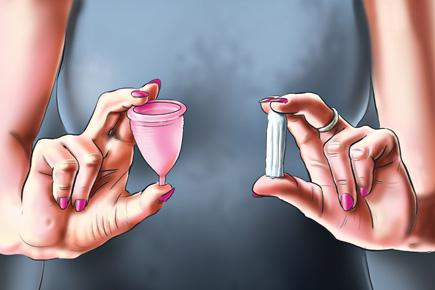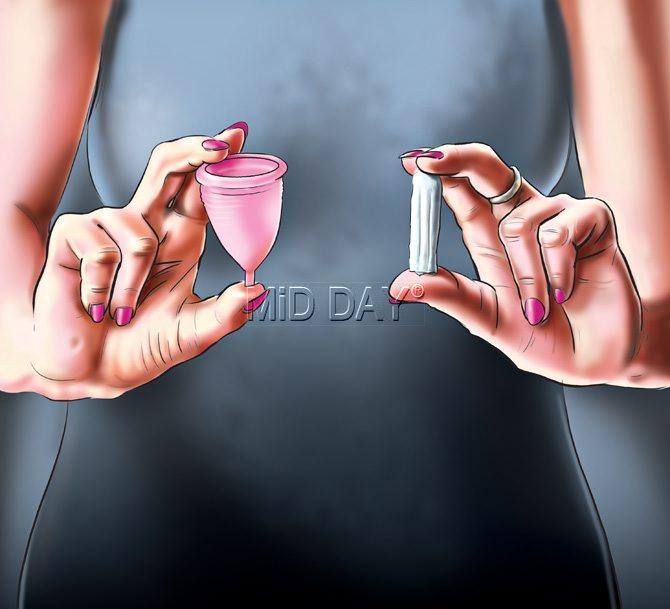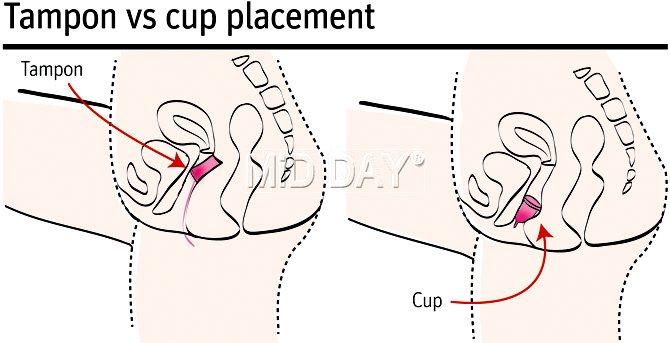Driven by an ecological conscience, an environment advocate ditches the sanitary pad to insert a silicon foreign object into herself, every month. Here's her story of apprehension, and the liberation that followed

ladies cup
![]() I made my big shift, from being a sanitary napkin and tampon user to a menstrual cup user, recently. Admittedly, at the fag end of my menstrual cycle — at almost 41 years of age — I am already in my perimenopausal stage according to my gynaecologist. Nevertheless, it was a move worth its salt and my sensibilities.
I made my big shift, from being a sanitary napkin and tampon user to a menstrual cup user, recently. Admittedly, at the fag end of my menstrual cycle — at almost 41 years of age — I am already in my perimenopausal stage according to my gynaecologist. Nevertheless, it was a move worth its salt and my sensibilities.
 Illustration/ Uday Mohite
Illustration/ Uday Mohite
ADVERTISEMENT
Yes, I am a 'green' freak — one of those weird people with some botched up wiring in their heads — who, as a child, made her mother's life miserable, militantly refusing plastic bags at the grocers, before environmental degradation was even a major issue. Later, in my early years of menstruation, as a not-too-socially skilled teenager, I remember quite a few escapades with the sanitary napkin — including an unsuccessful and pretty filthy attempt to flush it down a toilet while on a visit to a relative's home one holiday season.
If you have the appetite to hear the conclusion, I finally got out of the 'sticky' situation, by pulling the napkin out with my bare hands, wrapping it in a plastic bag and dumping it from the third-floor window in the still of the night. A clumsy crime, artfully executed, but hey, it wasn't my city and it wasn't my neighbourhood. The next morning, nothing happened and no one came to the door.
 Illustration/ Uday Mohite
Illustration/ Uday Mohite
The ecological question
Such comical misadventures led to one thought in my head: why couldn't I flush down the pad? What does it contain? And more importantly, where does our menstrual waste go once we dispose is from our homes. Decades later, while working as an environment journalist in a national daily — and under unrelenting pressure to churn out 'groundbreaking' stories, I traced the answer.
There is no official data, but news reports have assessed that every month, approximately 432 million soiled sanitary pads find their way to the landfills in the country, weighing a staggering 9,000 tonnes. That's enough to cover over 24 hectares. Sanitary towels are non-biodegradable since they contain plastic, and cannot be wholly incinerated. And finally, let's face it, they are a reason why most women who stand up for the rights of garbage pickers and conservancy workers, as well as human dignity in general, hang their heads in shame, in acceptance of the ironies of modern-day life. I confess I have gone through the feelings myself.
I first heard of the menstrual cup about three years ago, when I answered an online quiz on personal hygiene. By then, having moved full time into the social sector and working as an environmentalist and conservator with a strong human rights bent, the revelation was liberating at various levels. I thought of how much lesser sanitary pads and tampon waste I would contribute to the environment; how, when the next time someone talked about human dignity, I would feel closer to being a true-blue proponent; and not to forget, that secret pat on my back that says I am not a talker, but a doer.
I indulged in some elementary arithmetic as well. If I bought a decent cup for a few thousand rupees, I would save a fair bit on monthly pad and tampon purchase for the rest of my life.
The cup arrives
Even so, it took me three years to buy a menstrual cup online, which I finally did last month. It came packaged well, with an eco-friendly label, accompanied by an appealing pouch, some well-designed cloth pads with covers for extra safety and comfort, and a tiny pack of handmade paper soap.
At the onset, the cup, a soft, silicon, flexible funnel-shaped structure with a wide enough mouth, didn't look like something I'd like to insert into myself while menstruating. The instruction manual suggested a few dry runs (wearing the cup on non-period days), but I was too lazy for the effort.
So finally, when the day arrived, and I had to use the cup, the feeling wasn't exactly of excitement. To start with, I couldn't fold the cup well — the C-fold suggested in the manual was not easy to achieve. The cup would pop open before it was fully inserted. In all the panic, my muscles refused to relax and loosen. Operation aborted. I returned to the old comfort of the pad and had almost decided to dump the new purchase as worthless.
Later, being the obstinate adventurer I am, I approached the modern-day saviour — the World Wide Web. Wikihow offered me a step-by-step run-through on usage along with a detailed video on folding technique.
Well-armed, I attempted using it again that night.
So, here's the real deal on my experience, and why I would recommend the cup to everyone who has had patience to read this.
The liberation: It goes far beyond ethics and principles. Imagine an absolutely stain-free second day of period. No stain on your bedsheet, PJs and yes, no stains on the underwear. That's because the cup creates a vacuum in your vaginal cavity and stays intact all through the night, steadfastly collecting the menstrual fluids, with no possibility of a leak. The theory is easy to understand. Remember those hand plungers we use when drains clog?
So this morning, I pulled out the cup, drained the fluids, washed it thoroughly and it was ready for use again. Yes, it felt a bit yucky at first, but I'd choose this over hand-washing those stained clothes.
The education: I have wondered how much I bled, and whether it was too much or too little. The cup, bearing measurements, for the first time let me see how much.
The portability: It won't get exhausted. I won't have the worry of where to dispose it and where to find new stock, especially when travelling. And it's relatively easy to use, clean, store and carry.
The cost-effectiveness: It's a one-time investment and you won't spend more than Rs 2,000 for a decent one. Finally, some advice. Read up online before you decide to use it. Watch videos and ensure every question in your head is answered. Mine included some inane ones, like can I sleep with it, can I pee with it, will it get stuck, will it cause any infection, should I lubricate it before use. I found practical answers to them all. Better still, consult your gynaec on your next visit. Using the menstrual cup involves as much a mental shift as a physical one. My guess is, once you get used to the convenience and simplicity it offers, you are most likely to make it a habit.
The writer is a former reporter who works in environment and wildlife conservation
What is a menstrual cup?
It is a bell-shaped cup made of flexible, soft medical grade silicon, which is inserted into the vagina to contain menstrual fluids. It comes in two sizes for larger and smaller body types and is usually not more than two inches long. It can be folded and easily inserted and fitted right under the cervix. Make sure you hold the cup in a slight downward slant for easy inserting. Once in, the cup pops open creating a vacuum on the vaginal wall and collecting the menstrual fluid. Depending on your flow, you may need to dislodge the cup, drain out the fluids, wash and reinsert once every three to 12 hours.

History
The modern day menstrual cup was invented, patented and marketed by Leona W Chalmers, an American-born actress and author in 1937. Evolving from rubber to latex, the first silicon menstrual cup (Mooncup), was developed in the UK in 2002.
In India, it first made an entry as a device to facilitate stem cell storage. Dr Kiran Coelho, head of gynaecology at Bandra's Lilavati Hospital, says, "The menstrual cup is an excellent alternative to sanitary pads and tampons and I have been regularly advocating it to my patients."
Why use it?
According to Coelho, besides being eco-friendly, it is also scientifically sound. "Pads and tampons work on the principle of absorbing the menstrual fluids and hence can be rough and cause rashes. Tampons reach up to the cervix and absorb the blood before it flows down. Hence, infections like chronic cervicitis could occur. The menstrual cup works on a different principle — it allows the blood to naturally flow, and simply collects it. Hence, it is the least intrusive of all methods," she says.

Dos and don'ts
Do: Consult your gynaecologist before purchase and get your first-time fitting right.
Do: Check your flow every few hours during the first use to make sure the cup is not full.
Do: Make sure you sterilise the cup in hot water after every cycle.
Don't: Use if you have had a pelvic organ prolapse.
Don't: Use if you are using any intrauterine contraceptive.
Disadvantages
The only disadvantage of the cup, according to Dr Coelho, is in case of water unavailability. "Hygiene is imperative while handling the cup. You need to make sure you wash your hands thoroughly before and after insertion. Also running water is necessary to wash the cup when removed and before reinsertion. If water is scarce, you could have a problem on hand."
 Subscribe today by clicking the link and stay updated with the latest news!" Click here!
Subscribe today by clicking the link and stay updated with the latest news!" Click here!







